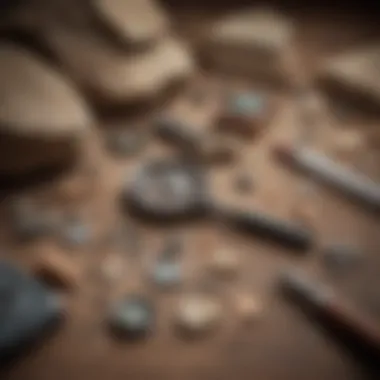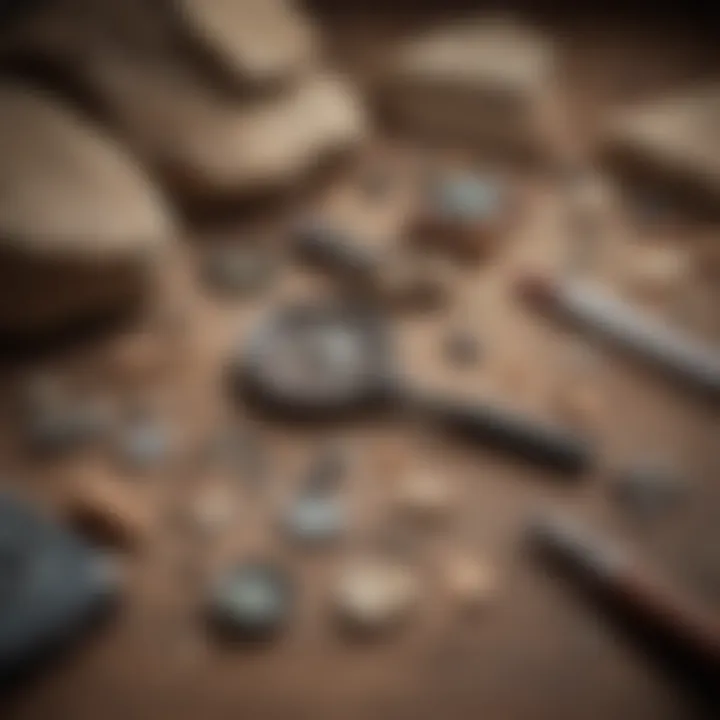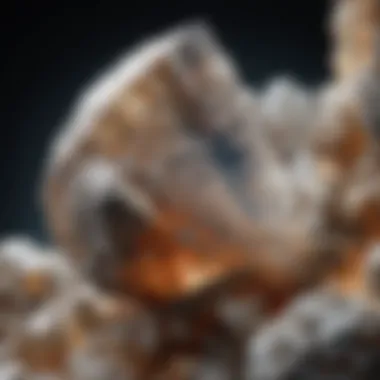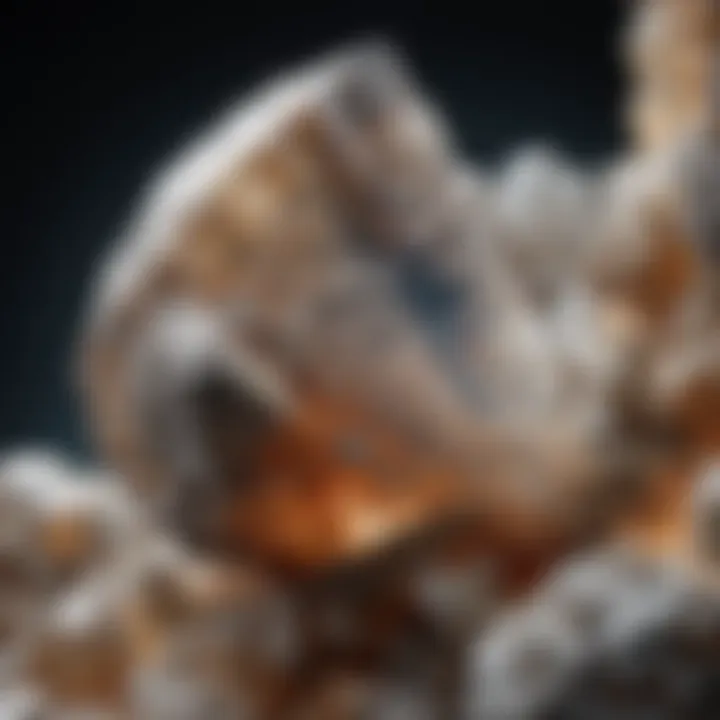A Comprehensive Guide to Identifying Gems and Minerals


Intro
Identifying gems and minerals forms the backbone of an informed collector's practice. A nuanced understanding of the properties that distinguish various specimens is essential for anyone passionate about geology, whether a novice or a seasoned enthusiast. Proper identification not only helps in appreciating the beauty of these natural forms but also enhances their value and significance.
One must engage with the complexities of physical characteristics, which include hardness, color, luster, and clarity. Tools to aid in identification have evolved, ranging from simple hand lenses to more sophisticated devices like refractometers and microscopes. Beyond the hardware, knowledge of geological formation processes and the historical narratives surrounding each type of gem or mineral contribute to a well-rounded collector’s perspective.
This article aims to guide you through these multi-faceted aspects of gemology and mineralogy, discussing the importance of accurate identification and classification. By increasing your competencies in this area, you can enjoy deeper connections with your specimens while cultivating a more informed and respectful collecting practice.
Featured Collectible of the Month
Overview
In this segment, we spotlight a fascinating gem or mineral that offers both beauty and scientific interest. For this month, we feature the stunning Amethyst. Known for its rich purple color, this quartz variant is highly sought after by collectors and jewelers alike. Amethyst has notable clarity and can also present in various hues from light lavender to deep violet.
Historical Significance
The historical narrative of Amethyst is rich, with roots tracing back to ancient civilizations. Once considered a precious stone, it adorned royal crowns and was believed to possess protective properties. In various cultures, Amethyst signifies sobriety and balance, reflecting its name which derives from the Greek word "amethystos," meaning "not intoxicated." Understanding the cultural and historical context enriches the collector’s experience as it connects the present to the past.
Identification Techniques
Visual Characteristics
Identifying gems and minerals begins with keen observation of visual characteristics. Important features include:
- Color: Observe the hue, tone, and saturation.
- Clarity: Note inclusions and surface blemishes.
- Luster: Determine how light interacts with the surface, whether it is metallic, glassy, or dull.
- Crystal form: Recognize distinct shapes that can indicate specific minerals.
Recognizing these traits is vital because they form the foundation for further testing.
Resources for Identification
Multiple resources can assist in identifying gems and minerals effectively. Consider these:
- Field guides that outline common minerals and gemstones.
- Online platforms like Wikipedia and Britannica for detailed descriptions.
- Community forums on platforms such as reddit where enthusiasts share insights.
- Local mineralogy clubs or societies that offer workshops and hands-on experiences.
Using these resources can boost your confidence in identification, enhancing your collecting journey.
Intro to Gem and Mineral Identification
Understanding how to identify gems and minerals is crucial for both collectors and enthusiasts. This knowledge not only enhances appreciation for the beauty and complexity of these specimens but also aids in their proper classification and valuation. Accurate identification reduces the likelihood of mistakes, which can be costly and diminish the value of a collection. Through this guide, readers will gain insights into the critical methods and tools that ensure effective recognition of various gemstones and minerals, leading to greater informed choices.
Definition of Gems and Minerals
Gems and minerals are distinct categories of natural substances. Gems typically refer to precious or semi-precious stones that have been cut and polished for adornment. Examples include diamonds, rubies, and sapphires. Minerals, on the other hand, encompass a broader range of naturally occurring inorganic substances with identifiable chemical compositions and crystal structures. Common minerals include quartz, calcite, and mica. Each category has its own set of properties that can be examined and utilized during identification.
Importance of Accurate Identification
Accurate identification of gems and minerals is essential for several reasons.
- Value Assessment: Knowing the correct type and quality of a gem or mineral impacts its market value significantly. Misidentification can lead to overpricing or underpricing.
- Scientific Understanding: Correctly identified specimens contribute to a more extensive database for research and education in geology and gemology.
- Ethical Sourcing: Understanding the true nature of a gem alerts collectors to possible ethical implications in its trade, encouraging responsible collecting.
Proper identification ensures that collectors respect both the natural beauty and scientific significance of their specimens.
By grasping these aspects, collectors can build their collections with greater confidence while fostering a deeper connection to the materials they cherish.
Basic Properties of Gems and Minerals
Understanding the basic properties of gems and minerals is crucial for accurate identification. These properties serve as the building blocks for recognizing and differentiating various specimens. By familiarizing oneself with these characteristics, collectors and enthusiasts can make informed conclusions about the materials they encounter.
Physical Properties Overview
Color
Color is one of the most immediately noticeable properties when observing gems and minerals. It can have a significant impact on the initial perception of the specimen. The vibrant hues in gems such as ruby or sapphire can enhance value and desirability. However, color alone can be misleading. Variations may occur due to impurities or environmental factors during formation. Relying solely on color may lead to misidentification. It is essential to incorporate additional characteristics when evaluating specimens.
Hardness
Hardness measures a material's resistance to scratching. This property is often quantified using the Mohs scale, which ranges from talc as the softest to diamond as the hardest. For gemologists, understanding hardness is paramount, as it helps to classify stones and assess their durability. A diamond, for instance, is highly sought after not only for its beauty but also for its exceptional hardness. However, the scale can be somewhat subjective, as slight variations may exist with different specimens. Thus, testing hardness should be done with caution.


Luster
Luster refers to how light interacts with a mineral's surface. It can range from metallic to pearly, with numerous variations in between. The luster can affect the overall aesthetic appeal of a specimen, significantly impacting its market value. For example, diamonds exhibit a brilliant luster, which contributes to their popularity in jewelry. However, different types of luster can make it difficult to categorize gems, as some may appear similar at a glance. Detailed observation is necessary to distinguish between them, ensuring accurate identification.
Transparency
Transparency describes how light passes through a mineral. This property can be classified into three categories: transparent, translucent, and opaque. Understanding transparency is instrumental in identifying gems. For example, a clear quartz is prized for its transparency, while a stone like opal may present a more opaque appearance. Each type has its distinct characteristics and appeal. However, assessing transparency can sometimes be complicated by inclusions or impurities present in the stone, potentially obscuring light transmission.
Optical Properties
The optical properties of gems provide deeper insights into their behavior under light. These features are essential for gemologists and collectors alike, significantly influencing identification and valuation processes.
Refractive Index
The refractive index indicates how much light bends when entering a mineral. This measurement helps differentiate gems of similar appearance. Each mineral has a unique refractive index, allowing for precise identification through testing. For instance, the refractive index can help distinguish a cubic zirconia from a diamond. Effective use of this property can enhance the accuracy of identification. However, measuring refractive index may require specialized equipment, which can be a drawback for amateur enthusiasts.
Birefringence
Birefringence is the optical phenomenon where a single ray of light enters a mineral and splits into two rays. It is particularly useful for identifying certain crystals, such as calcite and tourmaline. The degree of birefringence can provide invaluable data that strengthens the identification process. This property also reveals more about the internal structure of the mineral. Such insights can be challenging to observe without proper tools, necessitating a deeper understanding of optical principles.
Pleochroism
Pleochroism refers to the ability of a mineral to exhibit different colors when viewed from different angles. This distinction can be a valuable factor in identifying certain gems like tanzanite or alexandrite. Recognizing pleochroism can significantly aid in narrowing down options, especially with specimens that may appear similar in normal light. However, identifying this property requires careful observation and sometimes specialized lighting conditions, which can pose challenges.
Chemical Composition
Chemical composition is a fundamental aspect that underlies the identity of every gem and mineral. Each specimen has a specific chemical makeup that plays a critical role in its characteristics. Knowing the chemical composition helps in categorizing stones accurately. For instance, the difference between diamond (pure carbon) and graphite (also carbon) lies in their arrangement at a molecular level. This knowledge not only aids in avoidance of misidentification but also enhances the overall appreciation for the materials at hand.
Essential Tools for Identification
Identifying gems and minerals necessitates more than just keen observation skills; it requires appropriate tools that enhance the accuracy of evaluations. The right tools not only streamline the identification process but also reduce errors that could arise from relying solely on visual inspection. These tools assist collectors in confirming the distinctions between similar specimens, ensuring their collections are both authentic and valuable.
Loupes and Microscopes
Loupes and microscopes are fundamental tools in gem and mineral identification. Their role is to magnify specimens, revealing details not visible to the naked eye. A standard 10x jeweler's loupe is often the first tool beginners use, allowing for quick visual assessments. More advanced collectors might invest in a microscope with variable magnification to conduct thorough examinations.
Using these tools, an individual can assess surface characteristics, inclusions, and other crucial attributes. Inclusions can reveal a lot about the stone’s origin and authenticity. Another important aspect is how different minerals interact with light, which these tools can effectively demonstrate.
Testing Kits and Equipment
Testing kits provide practical solutions for confirming the properties of gems and minerals. They often include scratch kits, which help assess hardness according to the Mohs scale. Additionally, some kits are designed to test specific tools that measure refractive index, typically with a refractometer.
The importance of testing kits cannot be overstated. They allow enthusiasts to validate their findings scientifically, moving beyond aesthetic appreciation to informed understanding. Access to such kits equips collectors with the ability to verify their specimens comprehensively, reducing the chance of misidentification.
Appraisal Scales
Appraisal scales serve as a reference for evaluating the quality and value of gems and minerals. Common scales include the GIA grading system and the 4 Cs of diamonds: carat, cut, color, and clarity. Understanding these scales is crucial, as they help individuals gauge the worth and authenticity of their specimens.
Using appraisal scales aids collectors in making educated decisions when purchasing or selling gems. These standards provide a framework for comparing stones, which is essential for anyone looking to build a serious collection.
When you rely on standardized appraisal scales, you ensure a level of consistency that enhances credibility within the gemology community.
In summation, essential tools for identification, such as loupes, microscopes, testing kits, and appraisal scales, are not merely accessories for collectors; they are indispensable allies in the quest for accurate identification and appreciation of gems and minerals.
Identification Techniques
Identification techniques form a critical element in the realm of gem and mineral study. These methods enable collectors and enthusiasts to accurately categorize and appreciate the specimens they encounter. Moreover, effective identification contributes not only to personal knowledge but also to broader discussions within the gemology community. Implementing appropriate techniques ensures the integrity and authenticity of collections, thus fostering responsible stewardship of natural resources. Therefore, a deliberate understanding of these techniques is essential for any serious collector.
Visual Inspection
Visual inspection serves as the initial step in identifying gems and minerals. This technique relies heavily on the observer’s eye for detail. Collectors examine color, clarity, and surface features directly. A specimen's color can vary significantly due to factors like lighting and impurities, making a trained eye crucial for correct identification. Moreover, defects such as inclusions or scratches can reveal a lot about the mineral's formation and history.
This process also involves the analysis of luster, which describes how light interacts with a mineral's surface. For example, glassy luster often indicates quartz, whereas a dull finish may suggest a different mineral. Developing an understanding of these characteristics enables collectors to make quick, informed decisions about their specimens.
Scratch Tests and Hardness Testing
Hardness testing is perhaps one of the most straightforward and effective identification techniques. The Mohs scale of mineral hardness ranks minerals from talc at 1 to diamond at 10. By performing scratch tests, collectors can determine where their specimen falls on this scale. For instance, if a mineral can scratch glass, it likely has a hardness above 5.5. This quantitative measure helps narrow down the possibilities and can significantly aid the identification process.


However, collectors should exercise caution when conducting scratch tests. Some minerals may be softer than they appear. Always use a standardized approach to ensure results are reliable and accurate.
Specific Gravity Testing
Specific gravity is a property that can distinguish minerals with similar appearances. This technique involves measuring the weight of a mineral against an equal volume of water. Specific gravity can provide valuable insights, especially for heavier or denser specimens. For example, pyrite may seem similar to gold, but its specific gravity is distinctly different.
This technique is critical for gem and mineral identification because it highlights differences that may not be apparent through visual inspection alone. Accurate specific gravity measurements can make the difference between correct identification and misclassifying a specimen.
Spectroscopy Techniques
Spectroscopy techniques take the identification process to a more advanced level by analyzing the interaction of light with minerals. Through spectroscopy, collectors can gather definitive data about a mineral’s chemical composition. By observing how a specimen absorbs and reflects different wavelengths of light, one can identify unique spectral lines corresponding to specific minerals.
This method requires some specialized equipment but can greatly enhance the authenticity of identification. Learning about these techniques opens a new dimension for serious collectors. It provides a scientific basis for discussions and can even assist in tracing the origins of gemstones and mineral specimens.
Understanding these techniques makes identifying gems and minerals not just a practical skill but an art that combines science and appreciation.
Common Mistakes in Identification
Identifying gems and minerals accurately is a nuanced endeavor. Common mistakes can lead to misidentification, affecting both the value and appreciation of pieces within a collection. Understanding these pitfalls is critical for both novice and experienced collectors. By being aware of frequent errors, collectors can enhance their evaluation skills and avoid common missteps in their journey.
Overreliance on Color
Color is often the first characteristic that attracts attention. However, relying solely on color can be misleading. Many gems, like spinel and ruby, may exhibit similar hues. This can lead to confusion and potential misclassification. For instance, a vibrant red spinel could easily be mistaken for a lesser-quality ruby due to superficial resemblance. Thus, it's essential to combine color observations with other properties like hardness and luster.
Some gems, such as tourmaline, can also display multiple colors, making the identification process more complex. Collectors are encouraged to use tools like loupes and microscopes to observe subtleties in color variations and structural characteristics. This method allows for a more thorough analysis than color alone.
Ignoring Multiple Properties
The beauty of gems and minerals lies not just in their appearance, but also in their unique physical and optical properties. Focusing on only one or two attributes can result in significant errors. For example, a mineral might appear similar to another based on visual inspection, yet have different chemical compositions, hardness levels, or luster characteristics.
To avoid this mistake, it is important to approach identification holistically. Testing for hardness with tools like a Mohs hardness kit can reveal critical differences between specimens presumed to be the same. Furthermore, factors like refractive index, transparency, and specific gravity should be assessed in conjunction with visual attributes. A systematic method of evaluating all relevant properties will lead to confident and accurate identifications.
Misidentification of Similar Specimens
Many collectors encounter specimens that may visually resemble one another but differ significantly in composition or value. A prime example is the distinction between amethyst quartz and iolite. While both may showcase shades of purple, their chemical and physical properties diverge considerably. Misidentifying these specimens can result in mispricing and misleading estimates regarding rarity.
To mitigate misidentification, it is prudent to document findings carefully. Photographic evidence, recorded measurements, and notes on properties can all serve to clarify distinctions over time. Utilizing community resources, such as forums or local gemology clubs, can also provide insight. Engaging with fellow collectors and professionals may offer additional perspectives that can help refine identification skills.
"An informed collector is a successful collector."
The Role of Documentation
Documentation plays a vital role in the field of gem and mineral identification. It encompasses various methods of recording details about individual specimens, which aids significantly in both personal and academic pursuits. By maintaining accurate records, collectors can trace the lineage of their specimens, understand variations, and make informed purchasing decisions. Furthermore, the benefits of proper documentation extend beyond mere record-keeping; they enhance the overall appreciation and value of the specimens in question. Collectors and enthusiasts can utilize the documentation to establish provenance and authenticity, critical factors in this niche but significant field.
Recording Findings
When identifying gems and minerals, one of the first steps is to record findings meticulously. This involves noting essential characteristics such as color, luster, and any anomalies present in a specimen. Easily overlooked aspects can provide valuable clues to the true identity of the gem or mineral.
- Characteristics to Record:
- Color and hue variations
- Hardness levels
- Unique inclusions
- Location of discovery
By systematically documenting these observations, collectors develop a clear profile for each specimen. Over time, this compilation becomes a valuable reference that can enhance future identification efforts. Additionally, having this information accessible can facilitate sharing within communities or forums, enriching discussions with factual data.
Using Visual Reference Materials
Visual reference materials are indispensable for gem and mineral identification. They provide a shortcut to understanding various specimens and their traits. Materials such as catalogs, online databases, and field guides serve as excellent tools in a collector's arsenal. These resources help in making comparisons against identified specimens, reducing the margin for error.
- Types of Visual References:
- Gem and mineral photo databases
- Educational websites like wikipedia.org and britannica.com
- Community-contributed photos from forums like reddit.com
Utilizing these references not only aids in identifying gems and minerals but also increases the overall knowledge base. Updates in visual references can lead to discovering new trends or variations in specimens, which is particularly beneficial for serious collectors seeking to expand their collections.
Community Resources and Forums
Engaging with community resources and forums offers a platform for sharing knowledge and findings regarding gem and mineral identification. These spaces foster an environment where enthusiasts can discuss challenges they face while identifying certain specimens and seek advice from experienced members.


- Benefits of Community Engagement:
- Access to collective knowledge and experiences
- Opportunities for collaboration on identification projects
- Networking with other collectors and experts
Platforms like facebook.com can also provide significant insights and real-time updates in the field. Active participation can lead to discovering new techniques and approaches to identifying specimens that may not be widely known.
Documentation is not merely an administrative task; it is a cornerstone of understanding and appreciation in the realm of gem and mineral identification.
Understanding Gemology
Gemology is a crucial aspect in the world of gems and minerals, acting as the foundation for identifying, classifying, and appreciating these natural wonders. For collectors and enthusiasts, understanding gemology equips one with the necessary knowledge to discern between different types of specimens. This knowledge extends to the evaluation of quality, authenticity, and even the market potential of gems. By delving into gemology, mineral collectors glean insights not only about the materials themselves but also the broader implications of sourcing and sustainability.
Prolusion to the Field of Gemology
Gemology is the scientific study of gems and precious stones. It encompasses various disciplines, including geology, mineralogy, and crystallography. Each of these fields plays a role in the comprehensive understanding of why gems possess unique characteristics. For collectors, this knowledge is essential. It aids in recognizing different types, grades, and values of gems.
Gemologists spend years studying and practicing their craft to refine their skills in identifying and appraising gems. This expertise is not just academic; it translates directly into practical applications in the field. Whether one is examining diamonds, sapphires, or rare minerals, the principles learned in gemology help ensure proper assessment.
Training and Certification Pathways
Pursuing education in gemology typically starts with formal training programs offered by various institutions. Programs differ in length and depth, ranging from a few weeks to several years. The Gemological Institute of America (GIA) is among the most recognized organizations, providing courses that lead to certification.
These courses often cover several key topics, including:
- Identification Techniques: Learning how to use tools and techniques for accurate identification.
- Quality Assessment: Understanding the four Cs of diamonds—carat, cut, color, and clarity—and similar factors for other gemstones.
- Laboratory Skills: Training in applied techniques and methodologies used in gem laboratories.
Certification from credible institutions validates the skills of an individual, enhancing their credibility in the marketplace. Many gemologists also join professional organizations, which offer networking opportunities and access to valuable resources.
"Understanding gemology is essential for anyone serious about gem collection. It reveals the intricate details of gems that can vastly influence their value and desirability."
In summary, gemology serves as both an art and a science. It provides invaluable tools for collectors to make informed decisions, ensuring that their appreciation for gems is grounded in a strong foundation of knowledge.
Sustainability in Collecting
Sustainability in collecting gems and minerals holds significant relevance in today's world. The practice incorporates various elements that promote ethical considerations and environmental stewardship. Collectors must recognize their impact on the planet. They should aim to support sustainable mining practices and reliable sources. This consciousness not only protects natural resources but also ensures that future generations can continue to enjoy the beauty and diversity of minerals and gems.
Ethical Sourcing Practices
Ethical sourcing practices play a crucial role in sustainable collection. It involves ensuring that gems and minerals are obtained without causing harm to the environment or local communities. Collectors can prioritize materials from mines that adhere to fair labor standards and environmental regulations.
Here are some noteworthy practices to consider:
- Verify the Origin: Research where the gemstones or minerals come from. Favor suppliers who transparently disclose the source.
- Support Artisanal Miners: Buying from small-scale miners can often promote better working conditions and economic opportunities for local communities.
- Avoid Conflict Minerals: Ensure that the gems do not fund violence or human rights abuses.
By focusing on ethical sourcing, collectors can contribute to the preservation of our ecosystems and communities, thus fostering a responsible collecting culture.
Conservation of Natural Resources
Conservation of natural resources is fundamental in the practice of gem and mineral collecting. Responsible collectors understand the urge to preserve resources for sustainability. This involves minimizing waste and ensuring that collecting activities do not deplete local environments.
Consider adopting the following strategies:
- Limit Environmental Footprint: Use sustainable methods when collecting materials. Avoid practices that lead to erosion or habitat destruction.
- Participate in Restoration Projects: Engage in or fund initiatives aimed at restoring previously mined areas to their natural state.
- Educate Others: Share knowledge about responsible practices with fellow collectors, fostering a community that values conservation.
"The future of our planet depends on how well we manage our natural resources today."
A commitment to sustainable practices in collecting gems and minerals supports not only personal collections but also the broader ecological balance. By emphasizing sustainability, collectors ensure that their passion does not harm the world around them.
Epilogue
The exploration of gem and mineral identification serves as a vital aspect of understanding the natural world and enriching one’s collection practices. Identification is not merely a process of naming a specimen; it encompasses a multitude of factors that contribute to the authenticity, value, and appreciation of gems and minerals. Engaging deeply with this topic offers specific benefits that include informed purchasing decisions, ethical collecting, and a greater appreciation for geological diversity.
The Future of Gem and Mineral Identification
Looking ahead, the future of gem and mineral identification seems promising. Advancements in technology will likely play a crucial role in enhancing identification methods. Innovations in spectroscopy and imaging techniques can provide deeper insights into gem structure and composition. Such developments can help in better distinguishing between similar specimens, reducing the chances of misidentification.
Moreover, there is an increased focus on sustainability and ethical sourcing, which influences how collectors approach identification. Knowledge on ethical practices will empower collectors to make choices that contribute positively to the environment and societies involved in gem production.
As more collectors turn to community resources and forums like Reddit or Facebook, access to shared knowledge will grow. This collaborative spirit can cultivate a culture of continuous learning and sharing, elevating identification standards across the board. Thus, staying current with trends and technological advances will be paramount for anyone involved in gem and mineral collection.
"Understanding the significance of each specimen is essential to fostering a richer collection experience."
In summary, the future of gem and mineral identification holds vast potential. As technology evolves and community engagement grows, we can expect the field to develop more refined techniques and sustain a focus on responsible practices.



